Have you ever wondered how many calories are in a 10 oz steak? Get ready to satisfy your curiosity as we embark on a flavorful journey!
When it comes to determining the number of calories in a 10 oz steak, there are several factors to consider, such as the cut of meat and how it is prepared. According to the first source, a 10 oz boneless, cooked steak contains approximately 714 calories, with 42.55g of fat and 77.37g of protein. The calorie breakdown is 55% fat, 0% carbs, and 45% protein.
Other sources provide nutrition information for various serving sizes of steak, with calorie counts ranging from 43 calories for 1 oz of boneless, cooked steak to 685 calories for a large, boneless steak. It’s important to note that the calorie content may vary slightly depending on the specific cut of steak and how it is cooked. Overall, steak can be a healthy option as it is a good source of protein, but it’s important to consume it in moderation and consider your overall calorie intake.
Key Takeaways:
- The caloric content of a 10 oz steak can vary depending on the cut of meat and how it is cooked.
- A 10 oz boneless, cooked steak contains approximately 714 calories.
- Steak is a good source of protein, but it’s important to consume it in moderation.
- Nutrition information for various serving sizes of steak can guide portion control.
- Consider your overall calorie intake when incorporating steak into your diet.
Understanding the Importance of Caloric Content in Steak
As we explore the caloric content of a 10 oz steak, let’s first understand why it’s valuable to be aware of the calories in our favorite meaty indulgence. Being mindful of the caloric content of steak is crucial for maintaining a balanced diet and making informed choices about our meals.
Steak is a popular choice for many meat lovers due to its rich flavor and protein content. However, it’s important to remember that steak can be high in calories, especially when consumed in larger portions. By understanding the caloric content, we can better manage our overall calorie intake and prevent overindulgence.
When it comes to steak, the caloric content can vary depending on various factors such as the cut of meat and how it is prepared. Grilling, broiling, or pan-searing a steak can result in different calorie counts compared to methods like frying or deep-frying. Additionally, certain cuts of steak, such as ribeye or T-bone, may have a higher fat content and therefore more calories than leaner cuts like sirloin or tenderloin.
By having an understanding of the caloric content of a 10 oz steak, we can make informed choices about portion sizes and balance our meals accordingly. Moderation is key, and by incorporating steak into a well-rounded diet, we can enjoy its delicious flavor while still managing our calorie intake.
| Caloric Content of Different Steak Cuts | Calories per Serving Size |
|---|---|
| Ribeye | 325 calories (4 oz) |
| Sirloin | 259 calories (4 oz) |
| T-bone | 450 calories (6 oz) |
| Tenderloin | 282 calories (4 oz) |
Remember, steak can be a delicious and nutritious part of a balanced diet when consumed in moderation. By understanding the caloric content and making informed choices, we can savor the flavor of a juicy steak while maintaining a healthy lifestyle.
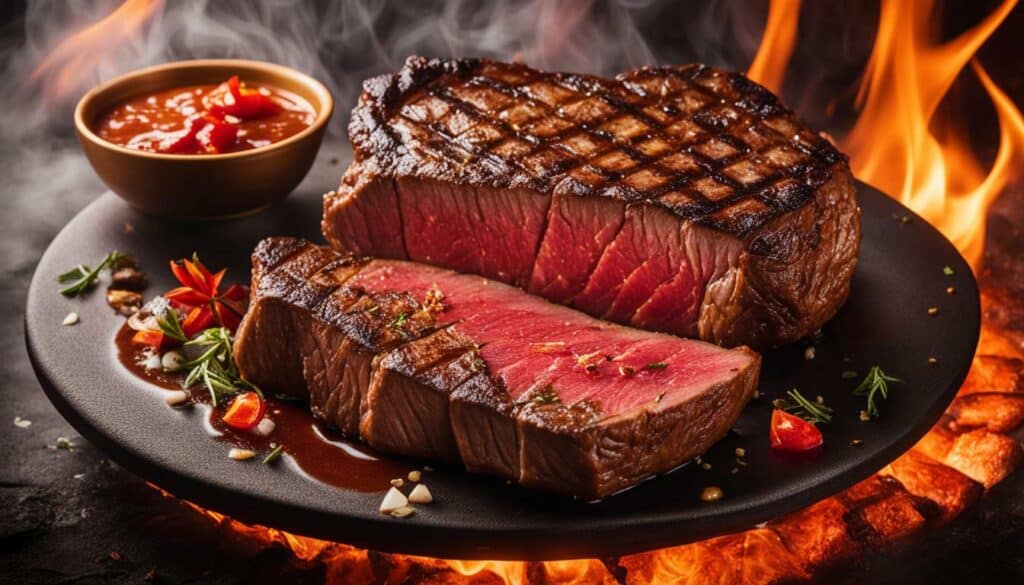
The caloric content of a 10 oz steak is influenced by various factors. Let’s take a closer look at these factors and understand how they affect the nutritional value of the steak.
Firstly, the cut of meat plays a significant role in determining the caloric content. Different cuts, such as ribeye, sirloin, or filet mignon, have varying amounts of fat marbling. Steaks with more marbling tend to have higher fat content and, subsequently, more calories. Conversely, leaner cuts like tenderloin have a lower fat content and fewer calories.
Secondly, the preparation method can also impact the caloric content. Grilling or broiling a steak allows excess fat to drip off, resulting in lower calories compared to pan-frying or breading, which can add extra fat and calories. Seasonings and marinades can also contribute to the overall caloric content, depending on the ingredients used.
Lastly, the cooking time and temperature can affect the nutritional value of the steak. Overcooking can cause fat to render out, resulting in a leaner and lower-calorie steak. On the other hand, undercooking may retain more fat, resulting in a higher caloric content. It’s essential to cook the steak to your desired level of doneness while considering the impact on calorie intake.
| Factors | Effect on Caloric Content |
|---|---|
| Cut of meat | Different cuts have varying fat content, which affects calories. |
| Preparation method | Grilling or broiling generally reduces calories compared to frying or breading. |
| Cooking time and temperature | Overcooking may lower calories, while undercooking may increase them. |
“The caloric content of a 10 oz steak can vary based on factors such as the cut of meat, preparation method, and cooking time and temperature. Understanding these factors is essential in assessing the nutritional value of the steak.” – Source: Nutrition Research Institute
Conclusion:
The caloric content of a 10 oz steak can be influenced by the cut of meat, preparation method, and cooking time and temperature. Choosing leaner cuts and healthier preparation methods, such as grilling, can help reduce calorie intake. It’s important to be mindful of these factors and consider them when planning your meals. Remember, moderation is key, and incorporating steak into a balanced diet can provide valuable nutrients while managing calorie consumption.
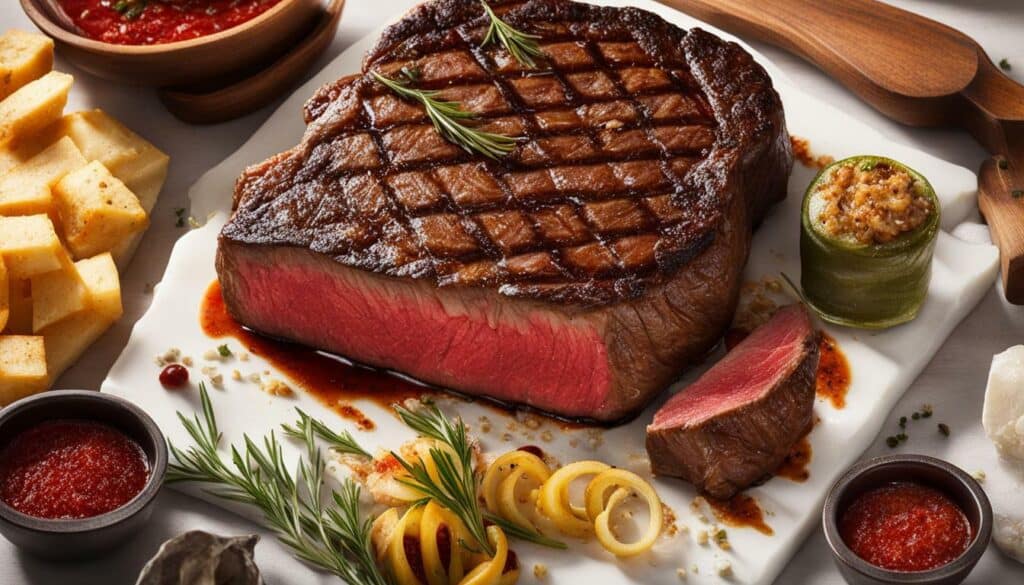
Let’s dive into the world of nutrition facts and discover the exact number of calories in a 10 oz steak. When it comes to determining the caloric content of a steak, it’s important to consider various factors, such as the cut of meat and how it is prepared. According to reputable sources, a 10 oz boneless, cooked steak contains approximately 714 calories.
Not only does this juicy piece of meat offer a satisfying protein boost, but it also comes with 42.55 grams of fat and 77.37 grams of protein. The breakdown for this caloric content is 55% fat, 0% carbs, and 45% protein. It’s important to note that the specific cut of steak and the cooking method can slightly alter the calorie count.
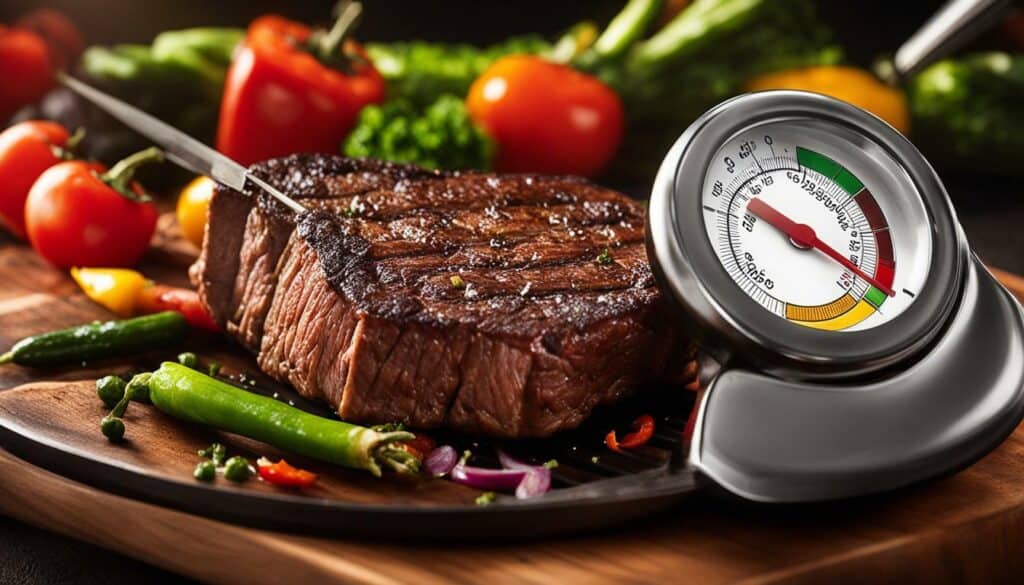
While the information for a 10 oz steak is helpful, it’s good to be aware of the calorie content for other serving sizes as well. For instance, a smaller 1 oz portion of boneless, cooked steak contains around 43 calories, while a larger, boneless steak can pack up to 685 calories.
As you enjoy your steak, keep in mind that it can be a nutritious option due to its high protein content. However, moderation is key. Consider your overall calorie intake and balance your meals accordingly. By being mindful of portion sizes and incorporating a variety of nutrients into your diet, you can savor the flavor of a 10 oz steak without compromising your calorie-conscious goals.
Variations in Caloric Content Based on Steak Cuts and Preparations
Are you curious about how the choice of steak cut and cooking style can alter the caloric content? Let’s find out!
When it comes to the caloric content of a 10 oz steak, it’s important to consider the various factors that can influence it. The type of cut and the method of preparation can have a significant impact on the number of calories you consume.
For example, a lean cut of steak, such as sirloin or tenderloin, generally has fewer calories compared to fattier cuts like ribeye or T-bone. This is because lean cuts have less marbling, which means they contain less fat. On the other hand, fattier cuts can contribute to a higher caloric content due to their increased fat content.
The way the steak is cooked also plays a role in its caloric content. Grilling or broiling typically allows some of the fat to melt away, resulting in a lower caloric value compared to pan-frying or deep-frying, where the steak may absorb more fat during the cooking process.
It’s worth noting that while the specific caloric content may vary based on these factors, steak remains a good source of protein. In moderation, it can be a satisfying and nutritious addition to a balanced diet. Just remember to consider your overall calorie intake and enjoy your steak as part of a well-rounded meal plan.
| Steak Cut | Calories per 10 oz | Protein (g) | Fat (g) |
|---|---|---|---|
| Sirloin | 450 | 65 | 18 |
| T-bone | 600 | 58 | 36 |
| Ribeye | 800 | 54 | 66 |
As always, it’s best to consult nutrition labels and professional resources for specific information on the caloric content of the steak you’re consuming. This way, you can make informed choices that align with your dietary goals and preferences.
Nutrition Information for Different Serving Sizes of Steak
Not only the size of a steak matters when it comes to caloric content. Join me as we explore the nutritional information for different serving sizes of steak. Whether you’re planning a hearty meal or watching your calorie intake, understanding the nutritional values of different portions is key to making informed choices.
Let’s start with a 1 oz serving of boneless, cooked steak. According to reputable sources, this small portion contains approximately 43 calories, 2.6g of fat, and 4.8g of protein. As the serving size increases, so does the caloric content. A 4 oz serving of boneless, cooked steak packs around 172 calories, 10.2g of fat, and 19.2g of protein.
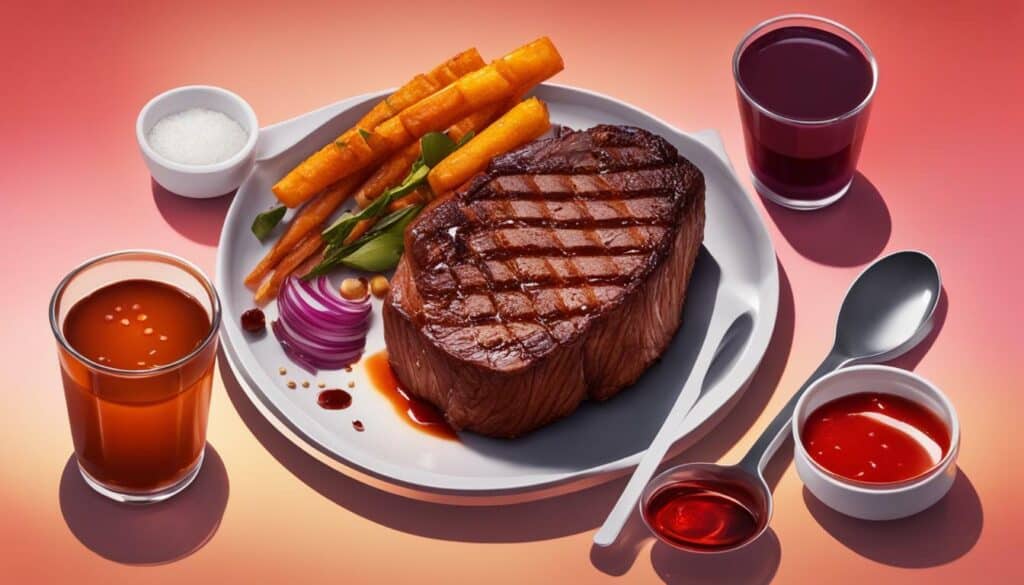
For those who prefer a heartier portion, a 10 oz boneless, cooked steak contains approximately 714 calories, 42.55g of fat, and 77.37g of protein. It’s important to note that different cuts of steak and cooking methods can affect these values to some extent. However, it’s also worth mentioning that steak is a good source of protein, making it a noteworthy addition to a balanced diet.
To give you a comprehensive overview, here’s a table summarizing the nutrition information for different serving sizes of steak:
| Serving Size | Calories | Fat (g) | Protein (g) |
|---|---|---|---|
| 1 oz (boneless, cooked) | 43 | 2.6 | 4.8 |
| 4 oz (boneless, cooked) | 172 | 10.2 | 19.2 |
| 10 oz (boneless, cooked) | 714 | 42.55 | 77.37 |
Take this information into consideration when planning your meals and be mindful of your portion sizes. Don’t forget that balancing your overall calorie intake is equally important. Enjoy your steak in moderation as part of a well-rounded diet.
Moderation and Overall Calorie Intake
Balance is key when it comes to enjoying steak while watching your calorie intake. Let’s explore the significance of moderation and learn how to incorporate steak into a healthy eating plan.
When it comes to steak, it’s important to remember that moderation is crucial. While steak can be a nutritious and protein-rich choice, consuming it in excess can lead to an imbalance in your overall calorie intake. It’s essential to consider the caloric content of the steak and how it fits into your daily calorie goals.
One way to incorporate steak into a calorie-conscious diet is by practicing portion control. Instead of indulging in a large 10 oz steak on its own, consider pairing it with a variety of nutrient-packed sides, such as roasted vegetables or a crisp salad. This allows you to enjoy the flavors of the steak while still maintaining a balanced plate.
| Serving Size | Calories | Protein | Fat |
|---|---|---|---|
| 1 oz of boneless, cooked steak | 43 | 5.3g | 2.3g |
| 4 oz of boneless, cooked steak | 172 | 21.3g | 9.2g |
| 8 oz of boneless, cooked steak | 344 | 42.5g | 18.3g |
Additionally, considering the overall calorie intake throughout the day is crucial. If you plan to have a 10 oz steak as part of your meal, make sure to adjust your other meals and snacks accordingly to maintain a balanced calorie intake.
Remember, it’s not just about the numbers on the scale, but also about nourishing your body with a variety of nutrients. Incorporating lean proteins, such as steak, into your diet can provide essential amino acids and promote satiety. By approaching steak consumption with moderation and mindful portioning, you can enjoy this delicious protein source while maintaining a healthy eating plan.
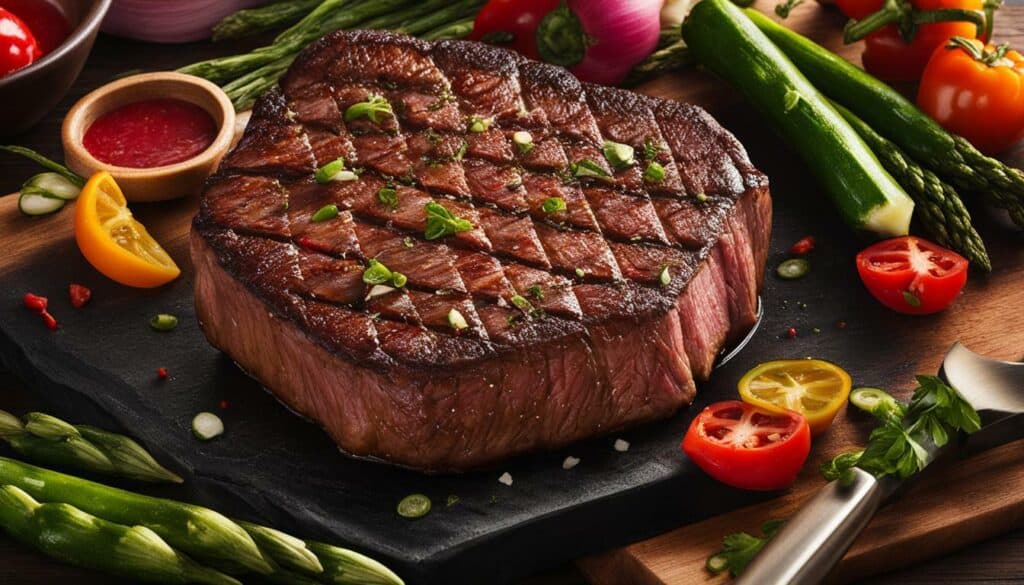
Steak isn’t just about the calories. Join me as we uncover the health benefits that make it a valuable addition to your meal plan. While steak is often associated with being high in fat and calories, it also offers various nutritional advantages that can boost your overall well-being.
Protein Powerhouse: One of the key health benefits of steak is its high protein content. Protein plays a crucial role in building and repairing tissues, supporting muscle growth, and regulating various bodily functions. A 10 oz steak can provide you with a significant amount of protein, helping you meet your daily dietary needs and promoting muscle strength and recovery.
Nutrient-Rich: Steak is a rich source of essential nutrients that your body needs to function optimally. It contains important vitamins and minerals like iron, zinc, vitamin B12, and selenium. Iron is vital for transporting oxygen throughout the body, while zinc supports immune function and promotes wound healing. Vitamin B12 is necessary for proper nerve function, and selenium acts as an antioxidant, protecting cells from damage.
| Nutrients | Amount per 10 oz Steak |
|---|---|
| Iron | 4.58 mg |
| Zinc | 9.25 mg |
| Vitamin B12 | 6.1 mcg |
| Selenium | 56.5 mcg |
“Steak provides essential nutrients like iron, zinc, vitamin B12, and selenium, supporting various bodily functions and promoting overall health.”
Reduces Anemia Risk: Anemia is a condition characterized by low levels of red blood cells or hemoglobin, leading to fatigue, weakness, and reduced oxygen transport. Steak is an excellent source of heme iron, which is more readily absorbed by the body compared to non-heme iron found in plant-based foods. Consuming steak can help prevent iron deficiency anemia and boost your energy levels.
While steak offers numerous health benefits, it’s essential to consume it in moderation. The American Heart Association recommends limiting your intake of red meat, including steak, to decrease the risk of heart disease. Pairing steak with nutrient-dense vegetables and whole grains can help create a well-balanced meal that supports your overall health and wellness.

Steak isn’t just a delicious indulgence; it can also be a nutritious addition to your diet. With its high protein content, essential nutrients, and potential to reduce the risk of anemia, steak offers health benefits that should not be overlooked. Remember to enjoy steak in moderation and make choices that align with your overall calorie intake and dietary goals.
Tips for Grilling a Delicious and Healthy 10 oz Steak
It’s time to fire up the grill and explore how to cook a mouthwatering 10 oz steak that is both delicious and nutritious! Grilling is a great way to enhance the natural flavors of the meat while keeping it lean and healthy. Here are some tips to ensure your steak turns out perfect every time:
- Choose a lean cut: Opt for a leaner cut of steak to keep the calorie content in check. Look for labels such as sirloin, tenderloin, or filet mignon, which are typically lower in fat.
- Marinate for flavor: Marinating your steak not only adds delicious flavor but also helps tenderize the meat. Choose a marinade that complements the natural flavors of the steak and let it soak for at least 30 minutes before grilling.
- Preheat the grill: Before placing your steak on the grill, make sure it is preheated to the proper temperature. This ensures that the steak cooks evenly and develops a beautiful sear on the outside while remaining juicy on the inside.
- Use a meat thermometer: To ensure your steak is cooked to your desired level of doneness, use a meat thermometer. The USDA recommends an internal temperature of 145°F for medium-rare, 160°F for medium, and 170°F for well-done.
- Let it rest: After grilling, allow your steak to rest for a few minutes before slicing. This helps the juices redistribute throughout the meat, resulting in a more tender and flavorful steak.
By following these tips, you can enjoy a delicious and healthy 10 oz steak that is packed with flavor and nutrition. Remember, moderation is key, so pair your steak with a balanced side dish and enjoy it as part of a well-rounded meal. Now, let’s fire up that grill and get cooking!
Table: Recommended Internal Temperatures for Steak Doneness
| Doneness | Internal Temperature (°F) |
|---|---|
| Medium-Rare | 145°F |
| Medium | 160°F |
| Well-Done | 170°F |
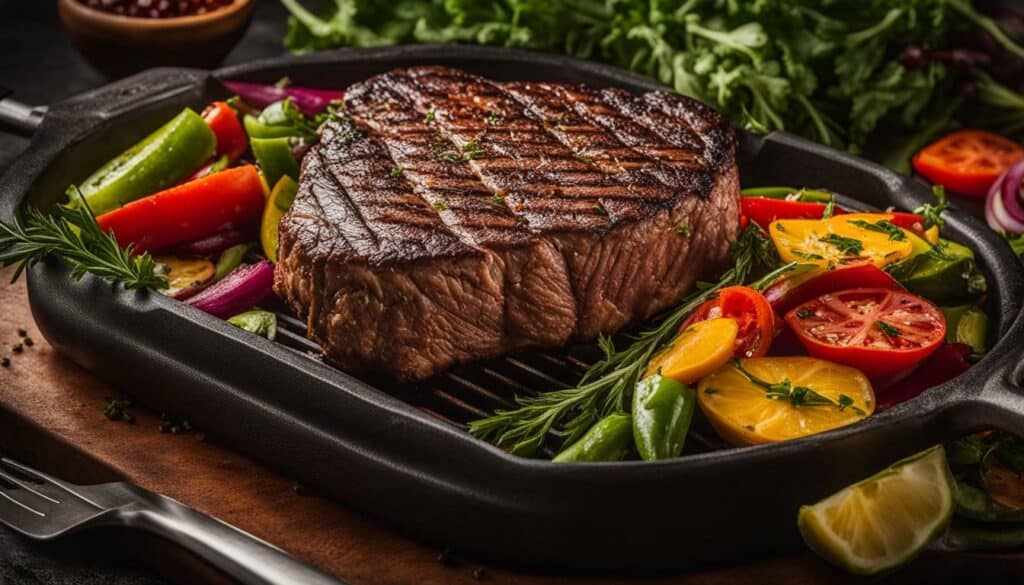
Conclusion
Armed with this knowledge, you can now indulge in a mouthwatering 10 oz steak while maintaining a calorie-conscious approach to your meals.
When it comes to determining the number of calories in a 10 oz steak, there are several factors to consider. The cut of meat and how it is prepared can have an impact on the caloric content. According to reputable sources, a 10 oz boneless, cooked steak contains approximately 714 calories, with 42.55g of fat and 77.37g of protein. The calorie breakdown is 55% fat, 0% carbs, and 45% protein.
It’s important to note that the calorie content may vary slightly depending on the specific cut of steak and how it is cooked. Other sources provide nutrition information for various serving sizes of steak, with calorie counts ranging from 43 calories for 1 oz of boneless, cooked steak to 685 calories for a large, boneless steak.
Despite its caloric content, steak can be a healthy option as it is a good source of protein. Incorporating steak into your diet can offer various health benefits due to its nutrient profile. However, it’s crucial to consume steak in moderation and consider your overall calorie intake to maintain a balanced diet.
FAQ
Q: How many calories are in a 10 oz steak?
A: The number of calories in a 10 oz steak can vary based on factors such as the cut of meat and how it is prepared. However, on average, a 10 oz boneless, cooked steak contains approximately 714 calories.
Q: What is the breakdown of macronutrients in a 10 oz steak?
A: A 10 oz boneless, cooked steak typically contains 42.55g of fat and 77.37g of protein. The calorie breakdown is approximately 55% fat, 0% carbs, and 45% protein.
Q: Are there variations in caloric content based on different cuts of steak?
A: Yes, the specific cut of steak can affect the caloric content. Different cuts may have slightly different calorie counts. It’s best to refer to specific nutrition information for the precise caloric content of the cut you are consuming.
Q: How does the cooking method impact the caloric content of a 10 oz steak?
A: The cooking method can also have an effect on the caloric content of a 10 oz steak. Grilling or broiling the steak can help reduce fat content, while pan-frying or adding sauces can increase the overall calorie count.
Q: Can you provide nutrition information for other serving sizes of steak?
A: Certainly! The calorie count for different serving sizes of steak can vary. For example, 1 oz of boneless, cooked steak contains approximately 43 calories, while a large, boneless steak may have around 685 calories. It’s important to consider portion sizes when determining your overall calorie intake.
Q: Is steak a healthy option to include in a balanced diet?
A: Steak can be a healthy option as it is a good source of protein and contains essential nutrients. However, it’s important to consume it in moderation and consider your overall calorie intake. Pairing steak with a variety of vegetables and whole grains can help create a balanced and nutritious meal.
How Many Calories Does Pink Lemonade Have Compared to a 10 oz Steak?
Pink lemonade is a refreshing summer beverage that many enjoy, but have you ever wondered about the calories in pink lemonade clarified? Well, compared to a 10 oz steak, pink lemonade contains significantly fewer calories. While a 10 oz steak can have around 500-600 calories, a glass of pink lemonade typically contains only about 120-150 calories. So, if you’re looking for a lighter option, choosing pink lemonade may be a better choice.

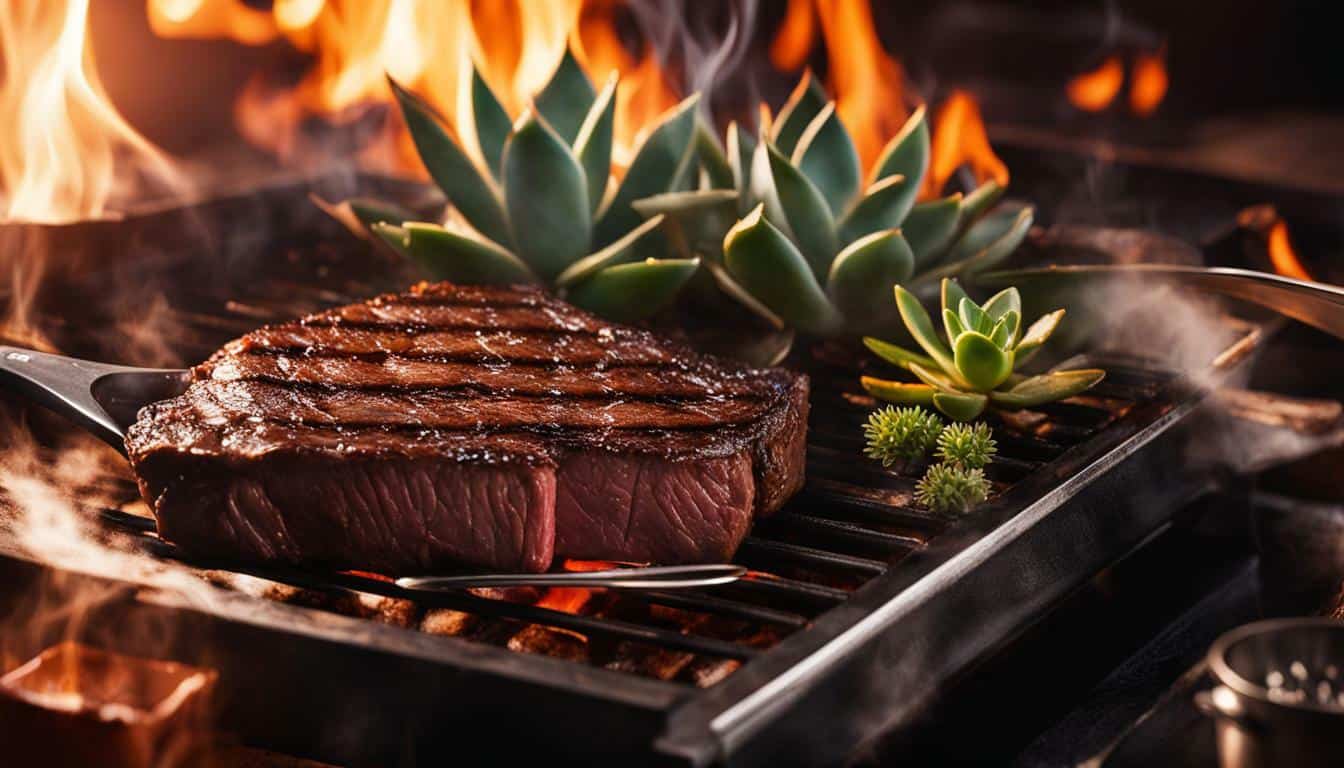



Leave a Reply